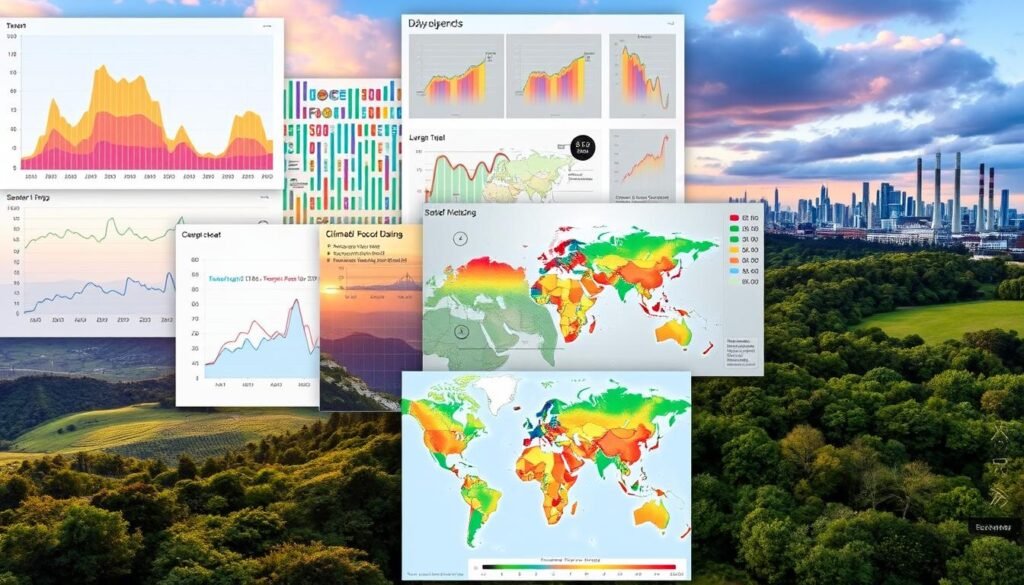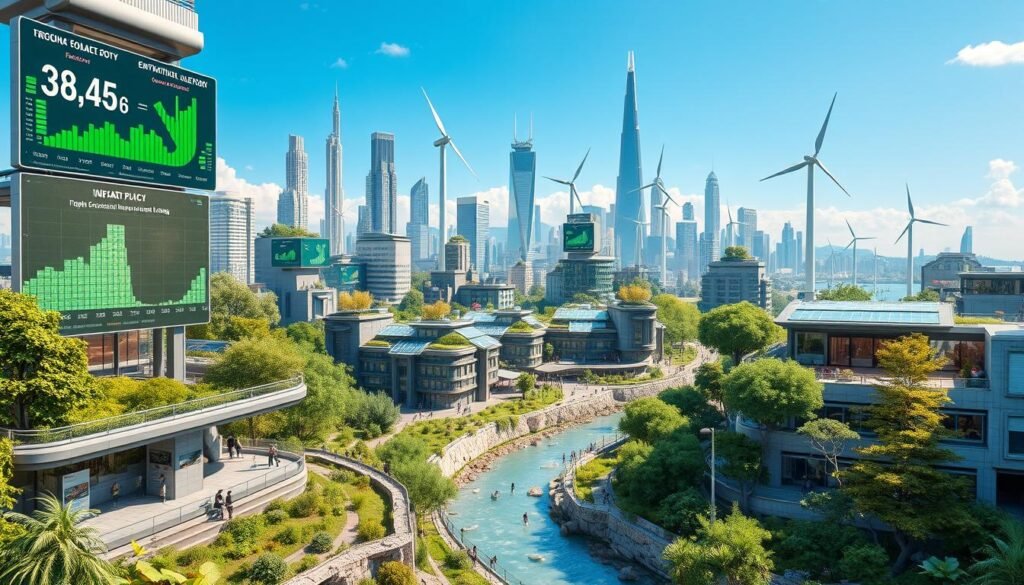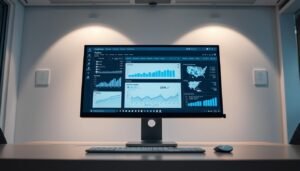Data science in climate change offers hope. Data scientists analyze data to find patterns and predictions, helping us move towards a sustainable future. Through environmental data science, we understand how our actions affect the Earth and the complex factors that change our climate.
Data-driven sustainability is more than just a concept. It’s a real framework for action. It combines advanced technology and caring for the environment. This allows us to make sense of big data, guiding decisions on policy, resources, and strategies to fight climate change.
To fight climate change, we need technology, science, and a commitment to a green planet. By using environmental data, we enter an era of active environmental management. Forecasting, simulation, and monitoring become key for taking care of our planet. Let’s explore how environmental data science is leading us to a sustainable world.
Key Takeaways
- Data science is key for understanding climate and promoting sustainability.
- Studying climate change data gives us insights for adapting to changes.
- Data-driven methods are vital for creating effective environmental policies.
- Advances in data analytics help us make smart choices for our planet.
- Environmental data science is critical for checking if we’re winning the fight against climate change.
- Using big data in climate research leads to a more informed and green future.
Understanding the Impact of Climate Data Analysis
Climate change is a big worry, and using strong climate data analysis is key. Experts use predictive modeling to understand big datasets. They aim to find ways to lessen the bad effects of climate change.
This work helps predict trends and get ready for environmental changes. It’s all about making sense of climate data.

Interpreting Climate Data for Better Predictions
Using climate data in new ways can change how we predict climate change. Data scientists turn complex numbers into easy-to-understand stories. This helps policymakers and the public get the message.
By making data visual, we can see the small details of climate changes. This helps us understand and tackle its big impacts.
Case Studies: Success Stories in Data Analysis
- Enhanced Flood Predictions: Scientists have made flood forecasting much better. This lets us get ready and use resources wisely when floods happen.
- Drought Management: By carefully analyzing climate data, areas at risk of droughts have found ways to save water. This has greatly reduced the harm from long dry spells.
Data-Driven Climate Policy Making
Data-driven climate policy making is changing how we tackle environmental issues. It uses climate change impact analysis and climate change prediction to help make better policies. These policies aim to reduce climate change’s harm and make our future more sustainable and resilient.
Good climate policy needs accurate data. This data helps leaders understand climate risks and how well their policies work. It guides them to make new policies or tweak old ones.

- It makes climate change predictions more accurate, helping us get ready for extreme weather.
- It helps create specific plans to fight climate change based on detailed climate change impact analysis.
- It makes resource use more efficient, focusing efforts and money on the most important issues.
This approach also helps us understand and talk about climate change better. It meets our immediate needs and teaches people about living sustainably.
| Policy Area | Data Utilization | Impact |
|---|---|---|
| Emission Reductions | Usage patterns, emission sources | Targeted reduction strategies |
| Disaster Response | Historical data, predictive models | Improved readiness and resource distribution |
| Urban Planning | Population density, climate risk analysis | Sustainable development planning |
Data-driven decision making is key. It makes sure our climate policies are not just reacting to problems but also looking ahead. This way, data-driven climate policy making is the heart of good environmental management.
Data Science in Climate Change
Data science has changed how we understand climate change. It uses big data to help us study and fight environmental problems. This new way of working is making a big difference.
The Evolution of Climate Change Research Data
More environmental data means better tools for studying climate change. Now, we can look at past climate patterns and current data together. This helps scientists see trends and predict the future.
They can also find ways to solve climate problems using this data. It’s a big step forward in understanding our planet.
Integrating Big Data in Climate Research Efforts
Big data is more than just a lot of information. It helps us find solutions for a better future. Tools now analyze huge amounts of data from all over to help us understand weather and carbon emissions.
This work is key in making plans to prevent climate damage. It’s not just about reacting to problems. It’s about stopping them before they start.
Data science is also important for making policies and raising awareness. It helps us create a more sustainable world. This is a big role for data science to play.
Advancements in Environmental Data Modeling
The field of environmental data modeling has changed a lot. It now uses machine learning to predict and fight climate change. These new tools help us tackle big environmental problems.
Innovative Approaches to Climate Modeling
Machine learning in climate science has changed how we look at big data. It uses special algorithms to find patterns in data. This helps scientists understand and predict the weather better.
These new methods make climate models more accurate and faster. This means we can respond quicker to environmental dangers.
Simulating Future Climate Scenarios
Creating models of future climates is key to planning against climate change. New environmental data modeling tools use powerful computers to show different climate futures. They help leaders make plans that are ready for anything.
If you’re looking into a career in this field, knowing about data science and environmental sustainability is important. This field needs people who can use data to make a difference in the climate.
| Technology | Application in Climate Modeling | Benefits |
|---|---|---|
| Machine Learning | Pattern recognition in climate variables | Enhanced predictive accuracy |
| Big Data Analytics | Handling complex, voluminous datasets | Efficient data processing and simulation |
| AI-driven Simulations | Future climate scenario modeling | Strategic planning and policy making |
Climate Change Modeling and Prediction Techniques
In environmental science, climate change modeling and climate forecasting algorithms are key. They help us understand future climates and plan for their impacts. Let’s explore how predictive modeling for climate science aids in decision-making.
Climate change modeling is complex. It simulates how different parts of the atmosphere work together. This lets scientists see long-term environmental changes, which is vital for climate research.
- Predictive modeling for climate science uses stats and machine learning to forecast climate changes. It shows how these changes might affect the world.
- With climate forecasting algorithms, researchers can better predict things like El Niño, ice melting, and extreme weather.
Here’s a look at different climate forecasting algorithms and their uses:
| Algorithm Type | Application | Effectiveness |
|---|---|---|
| Neural Networks | Temperature Prediction | High |
| Support Vector Machines | Precipitation Trends | Medium |
| Linear Regression | Sea Level Rise | High |
The table shows Neural Networks are top for predicting temperature. They’re a key tool in climate change modeling.
In summary, using advanced algorithms in climate change modeling boosts our ability to predict. It’s a key part of modern climate science.
Machine Learning in Environmental Science
The use of machine learning for climate change is changing how we tackle environmental issues. AI helps scientists analyze huge amounts of data better. This leads to smarter decisions in environmental science and policy.
Predictive analytics are key in understanding climate changes. They help predict weather patterns and manage resources during crises. AI for climate science is now essential.
- Pattern recognition: Machine learning finds patterns in complex climate data. This improves our understanding of environmental changes over time.
- Simulation of various scenarios: AI tools quickly simulate many environmental scenarios. This gives us valuable forecasts for planning.
- Risk assessment: AI tools predict climate disasters. They help us prepare better and lessen the harm of such events.
The mix of machine learning for climate change, AI for climate science, and predictive analytics leads to a proactive approach. It shows how technology helps us protect and preserve nature.
Leveraging Big Data Solutions for Environmental Impact
As we strive to balance growth with nature, big data solutions for environmental impact play a key role. These technologies change how we see and interact with our world. They also help in big data in environmental studies. Big data helps us make accurate predictions and strategies, which is key for a sustainable future and adapting to climate change.
Optimizing Resources with Data-Driven Solutions
Data-driven methods are making a big difference in how we use resources. By studying big data, companies and governments can work better and waste less. For example, water management has improved with predictive analytics, helping predict usage and avoid shortages.
Energy companies also use big data to adjust production based on real-time needs. This leads to less waste and a smaller environmental impact.
Challenges in Handling Environmental Big Data
The benefits of big data in environmental studies are huge, but so are the challenges. Issues like outdated infrastructure, privacy concerns, and the need for more tech investment are big hurdles. Also, the amount and type of data can be too much for current systems, needing better tools for handling and analyzing it.
| Challenge | Impact | Solution |
|---|---|---|
| Data Volume | Processing complexity increases | Upgrade data processing units |
| Data Variety | Integration issues | Implement advanced data management systems |
| Infrastructure | Limits data accessibility | Invest in robust IT infrastructure |
| Privacy Concerns | Public trust issues | Enhance data security measures |
To overcome these challenges and make data-driven climate adaptation strategies work better, we need to invest in new tech and train people to work with environmental data.
Data Visualization for Environmental Studies and Communication
Data visualization in climate research turns complex data into easy-to-understand visuals. These visuals tell stories about climate change and its effects. They help bridge the gap between scientific data and policy-making by showing trends that guide important decisions.
One key role of data visualization for environmental studies is making complex data simple. By converting large datasets into charts, graphs, and maps, researchers help us see environmental trends clearly. This makes it easier for everyone to understand the urgency of climate issues.
Using visual tools to share climate science findings raises public awareness. It also leads to more informed talks about environmental policies. A study on data-driven techniques in climate science shows how visuals can point out issues like rising sea levels and extreme weather events.
- Infographics illustrating the effects of global warming on polar ice caps.
- Interactive maps showing deforestation rates over time.
- Graphs that detail yearly changes in carbon dioxide emissions.
| Visualization Type | Key Feature | Purpose |
|---|---|---|
| Infographics | User-friendly, engaging | Simplify complex data |
| Interactive maps | Geo-tagging, real-time updates | Show spatial trends and impacts |
| Dynamic graphs | Time-lapse, scenario analysis | Forecast and simulate future conditions |
This table shows different data visualizations and their uses in environmental communication. These visuals help scientists and non-experts alike understand and tackle environmental issues.
In the end, data visualization in climate research is about more than just pretty pictures. It’s about turning data into stories that inspire change, shape policies, and encourage sustainable actions worldwide.
Predictive Analytics for Climate Impact Assessment
The use of predictive modeling for climate change has changed how we tackle environmental issues. It combines big data solutions for climate research to create advanced tools. These tools help predict weather and check if climate change plans work better than ever.
This section looks at how these technologies change climate change forecasting.
Developing Algorithms for Extreme Weather Forecasting
Modern forecasting relies on algorithms that predict extreme weather better. These algorithms use big datasets. They mix past weather with current data to help prepare for extreme weather.
Quantifying the Efficacy of Climate Change Mitigation Strategies
It’s key to know how well climate change plans work. Predictive analytics helps measure this. It lets us make changes and improve plans in real-time. This way, our efforts are focused and effective.
| Strategy | Impact Measurement | Data Utilized |
|---|---|---|
| Reforestation Projects | CO2 Emission Reduction | Satellite Imagery, Ground Sensor Data |
| Urban Planning Adjustments | Heatwave Mitigation | Urban Heat Maps, Demographic Data |
| Renewable Energy Integration | Reduction in Fossil Fuel Use | Energy Consumption Data, Weather Patterns |
Climate Change Analytics and Its Applications in Sustainability
In today’s world, climate change analytics are key to fighting climate change. They help us understand and act on environmental issues. This field uses environmental data analytics to give insights for better environmental actions.
By using data science, we can make farming, policies, and city planning better. This way, we can make decisions based on facts, not guesses. It helps us choose actions that are good for the planet.
- Using predictive models helps cities get ready for bad weather.
- Looking at environmental data helps us protect endangered places.
- Checking how well we’re doing with data helps us use resources better.
| Sector | Application of Climate Change Analytics | Impact |
|---|---|---|
| Agriculture | Predictive analytics for crop yields | Optimization of resource use and decrease in waste |
| Urban Planning | Assessment of infrastructure resilience | Enhanced preparations for climate-related challenges |
| Energy Management | Real-time data utilization for renewable energy sourcing | Increased adoption of sustainable energy solutions |
In conclusion, climate change analytics are vital for a sustainable future. They help us predict, analyze, and act on climate change. This way, we can make choices that help our planet and last for a long time.
Data-Driven Climate Adaptation Strategies and Solutions
In the fight against climate change, data-driven climate adaptation strategies are key. They use big data and machine learning for climate research. This helps policymakers and scientists find better ways to adapt and protect vulnerable areas.
These new methods predict climate impacts and create strong responses. They are essential for making sustainable and effective plans. Here’s how data-driven climate solutions help make things better and guide policy decisions.
Creating Resilient Ecosystems Through Data Analysis
Data analysis is vital for understanding how ecosystems react to climate changes. With machine learning for climate research, scientists can forecast changes and suggest ways to protect biodiversity. This helps keep ecosystems healthy and resilient against environmental challenges.
Informing Policy Decisions with Solid Data Evidence
Good data is essential for making smart environmental policies. Data-driven climate adaptation strategies use real-time data to support policy choices. This helps governments and organizations make laws that prevent climate damage. With detailed data, they can create better climate governance that meets global sustainability goals.
Conclusion
The importance of data science in climate change is huge. We’ve looked at how data science changes things, from helping make climate policies to improving models for predicting changes. It lets us see the future of our planet clearly, helping us act wisely.
Methods and tools like Python for climate data analysis give scientists and policymakers the power to understand big data. They find patterns and connections that help us move towards a sustainable future. Data science touches every part of studying the environment, making us better at understanding and fighting climate change.
To use data science fully, we need to keep researching and using advanced analytics. We also need to work together across different fields. The journey to a sustainable future is filled with data, and it’s our duty to follow this path with determination and smart strategies.
As we face the challenges of climate change, let’s keep being curious and innovative. We must strive for a world where living in harmony with nature is not just a goal, but a reality.
FAQ
How does data science contribute to climate change research?
Data science analyzes big datasets. It uses advanced analytics to understand climate patterns. This helps predict future trends and guide sustainable efforts.
What is the importance of climate data visualization?
Climate data visualization makes complex data easy to understand. It helps policymakers, scientists, and the public grasp climate change issues. This leads to better solutions.
How is predictive modeling used in climate change?
Predictive modeling uses past and current data to forecast future climates. It helps assess climate change’s impact. This is key for planning and adapting.
What role does machine learning play in environmental science?
Machine learning analyzes environmental data to find patterns and predict outcomes. It improves impact assessments. This supports effective climate change strategies.
How can data-driven solutions optimize natural resource management?
Big data solutions analyze resource use patterns. They help optimize and improve natural resource management. This reduces environmental impact.
What challenges do we face with environmental big data?
Managing large data volumes is a challenge. Ensuring data quality and addressing privacy concerns are also issues. Developing advanced analysis tools is needed.
Can data science influence climate policy making?
Yes, data insights are key for creating effective climate policies. They help mitigate environmental impact and address future effects.
What advancements in environmental data modeling are helping climate science?
New climate models use machine learning and AI. They lead to more accurate predictions. This helps simulate future climate scenarios.
How does data visualization aid in environmental studies?
Data visualization turns complex data into easy-to-understand graphics. It helps researchers and the public engage with climate science findings.
Why are data-driven adaptation strategies important for tackling climate change?
Data-driven strategies lead to evidence-based decisions. They help create resilient ecosystems. Solid data analysis enhances these strategies.
In what ways are climate change analytics applied to sustainability?
Climate analytics monitor environmental initiatives’ success. They guide sustainable practices and inform innovations. This supports long-term sustainability.
What is the significance of machine learning in climate change forecasting?
Machine learning improves climate forecast accuracy. It predicts extreme weather events. This is vital for early warnings and damage mitigation.






















2 thoughts on “Data Science In Climate Change to Building A More Sustainable World”
I am impressed with this site, real I am a big fan .
Fantastic beat ! I wish to apprentice even as you amend your web site, how can i subscribe for a blog website? The account aided me a appropriate deal. I were a little bit acquainted of this your broadcast offered vivid clear idea